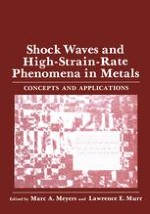1981 | OriginalPaper | Buchkapitel
Microstructure and Bonding Mechanism in Explosive Welding
verfasst von : Michael Hammerschmidt, Heinrich Kreye
Erschienen in: Shock Waves and High-Strain-Rate Phenomena in Metals
Verlag: Springer US
Enthalten in: Professional Book Archive
Aktivieren Sie unsere intelligente Suche, um passende Fachinhalte oder Patente zu finden.
Wählen Sie Textabschnitte aus um mit Künstlicher Intelligenz passenden Patente zu finden. powered by
Markieren Sie Textabschnitte, um KI-gestützt weitere passende Inhalte zu finden. powered by
The use of transmission electron microscopy (TEM) to examine the microstructure of the bonding zone in explosive welding is described. Plates of an aluminum copper alloy were heat-treated to produce a well defined microstructure. With such plates a series of claddings with different parameters and conditions were made. The microstructure of the bonding zone was then analysed. From the changes of microstructure within the bonding zone as compared to the microstructure of the material in the original state conclusions are drawn concerning the deformation process and the thermally activated reactions which take place during welding. The findings lead to a more comprehensive understanding of the explosive bonding process, including maximum temperature within the bonding zone, cooling rate, and deformation mechanism during the impact of the plates. It can be shown that bonding is achieved by short time melting followed by extremely rapid solidification and cooling of a very thin layer along the contact interface. A brief discussion on the generalization of the results to include materials with high melting temperature, and the correlation between the microstructure and properties of explosive welds is presented.
